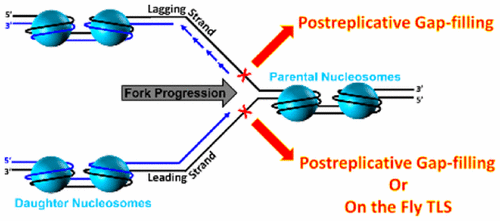当前位置:
X-MOL 学术
›
Chem. Rev.
›
论文详情
Our official English website, www.x-mol.net, welcomes your
feedback! (Note: you will need to create a separate account there.)
Eukaryotic Translesion DNA Synthesis on the Leading and Lagging Strands: Unique Detours around the Same Obstacle
Chemical Reviews ( IF 51.4 ) Pub Date : 2017-05-12 00:00:00 , DOI: 10.1021/acs.chemrev.7b00046 Mark Hedglin 1 , Stephen J Benkovic 1
Chemical Reviews ( IF 51.4 ) Pub Date : 2017-05-12 00:00:00 , DOI: 10.1021/acs.chemrev.7b00046 Mark Hedglin 1 , Stephen J Benkovic 1
Affiliation

|
During S-phase, minor DNA damage may be overcome by DNA damage tolerance (DDT) pathways that bypass such obstacles, postponing repair of the offending damage to complete the cell cycle and maintain cell survival. In translesion DNA synthesis (TLS), specialized DNA polymerases replicate the damaged DNA, allowing stringent DNA synthesis by a replicative polymerase to resume beyond the offending damage. Dysregulation of this DDT pathway in human cells leads to increased mutation rates that may contribute to the onset of cancer. Furthermore, TLS affords human cancer cells the ability to counteract chemotherapeutic agents that elicit cell death by damaging DNA in actively replicating cells. Currently, it is unclear how this critical pathway unfolds, in particular, where and when TLS occurs on each template strand. Given the semidiscontinuous nature of DNA replication, it is likely that TLS on the leading and lagging strand templates is unique for each strand. Since the discovery of DDT in the late 1960s, most studies on TLS in eukaryotes have focused on DNA lesions resulting from ultraviolet (UV) radiation exposure. In this review, we revisit these and other related studies to dissect the step-by-step intricacies of this complex process, provide our current understanding of TLS on leading and lagging strand templates, and propose testable hypotheses to gain further insights.
中文翻译:

前导链和滞后链上的真核跨损伤 DNA 合成:绕过相同障碍的独特弯路
在 S 期,轻微的 DNA 损伤可以通过绕过此类障碍的 DNA 损伤耐受 (DDT) 途径来克服,从而推迟对有害损伤的修复,以完成细胞周期并维持细胞存活。在跨损伤 DNA 合成 (TLS) 中,专门的 DNA 聚合酶会复制受损的 DNA,从而允许复制聚合酶在损伤之外恢复严格的 DNA 合成。人体细胞中这种滴滴涕途径的失调会导致突变率增加,从而可能导致癌症的发生。此外,TLS 使人类癌细胞能够抵抗化学治疗剂,这些化学治疗剂通过破坏活跃复制细胞中的 DNA 来引发细胞死亡。目前,尚不清楚这一关键途径是如何展开的,特别是 TLS 在每个模板链上发生的位置和时间。鉴于 DNA 复制的半不连续性质,前导链和滞后链模板上的 TLS 对于每条链来说可能都是唯一的。自 20 世纪 60 年代末发现 DDT 以来,大多数关于真核生物 TLS 的研究都集中在紫外线 (UV) 辐射暴露引起的 DNA 损伤上。在这篇综述中,我们重新审视这些和其他相关研究,逐步剖析这个复杂过程的复杂性,提供我们目前对前导链和滞后链模板上的 TLS 的理解,并提出可测试的假设以获得进一步的见解。
更新日期:2017-05-12
中文翻译:

前导链和滞后链上的真核跨损伤 DNA 合成:绕过相同障碍的独特弯路
在 S 期,轻微的 DNA 损伤可以通过绕过此类障碍的 DNA 损伤耐受 (DDT) 途径来克服,从而推迟对有害损伤的修复,以完成细胞周期并维持细胞存活。在跨损伤 DNA 合成 (TLS) 中,专门的 DNA 聚合酶会复制受损的 DNA,从而允许复制聚合酶在损伤之外恢复严格的 DNA 合成。人体细胞中这种滴滴涕途径的失调会导致突变率增加,从而可能导致癌症的发生。此外,TLS 使人类癌细胞能够抵抗化学治疗剂,这些化学治疗剂通过破坏活跃复制细胞中的 DNA 来引发细胞死亡。目前,尚不清楚这一关键途径是如何展开的,特别是 TLS 在每个模板链上发生的位置和时间。鉴于 DNA 复制的半不连续性质,前导链和滞后链模板上的 TLS 对于每条链来说可能都是唯一的。自 20 世纪 60 年代末发现 DDT 以来,大多数关于真核生物 TLS 的研究都集中在紫外线 (UV) 辐射暴露引起的 DNA 损伤上。在这篇综述中,我们重新审视这些和其他相关研究,逐步剖析这个复杂过程的复杂性,提供我们目前对前导链和滞后链模板上的 TLS 的理解,并提出可测试的假设以获得进一步的见解。











































 京公网安备 11010802027423号
京公网安备 11010802027423号